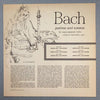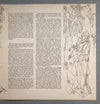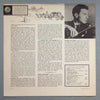











Bach - Partitas & Sonatas for unaccompanied violin - Nathan Milstein (3LP, Box set, Mono)
Johann Sebastian Bach - Partitas & Sonatas for unaccompanied violin
Nathan Milstein - violin
3 LP, Box set with 4 page panel insert
Original analog Master tape : YES
Heavy Press : 180g
Record color : black
Speed : 33 RPM
Size : 12'’
Mono
Studio
Record Press : Pallas
Label : Analog Phonic
Original Label : Capitol Records
Recorded at Capitol Studio A, 46th Street, New York City on 26 & 31 March 1954 (Sonata No. 1 ), 6 February 1956 (Partita No. 1 ), 27 December 1956 (Sonata No.2), 23-24 March 1954 (Partita No.2), 5 & 16-17 March 1956 (Sonata No.3), 28 December 1955 (Partita No.3)
Engineered by Frank Abbey
Produced by Richard C. Jones
Remastered by Rainer Maillard at Emil Berliner Studios
Originally released in 1957
Reissued in June. 2019
Tracks:
Side A
Sonata No. 1 In G Minor, BWV 1001
1. Adagio
2. Fuga. Allegro
3. Sicilana
4. Presto
Side B
Partita No. 1 In B Minor, BWV 1002
1. Allemanda
2. Double
3. Corrente
4. Double. Presto
5. Sarabanda
6. Double
7. Tempo Di Borea
8. Double
Side C:
Sonata No. 2 In A Minor, BWV 1003
1. Grave
2. Fuga
3. Andante
4. Allegro
Side D:
Partita No. 2 In D Minor, BWV 1004
1. Allemanda
2. Corrente
3. Sarabanda
4. Giga
5. Ciaccona
Side E:
Sonata No. 3 In C Major, BWV 1005
1. Adagio
2. Fuga
3. Largo
4. Allegro Assai
Side F:
Partita No. 3 In E Major, BWV 1006
1. Preludio
2. Loure
3. Gavotte En Rondeau
4. Menuet I
5. Menuet II - Menuet I Da Capo
6. Bourrée
Awards:
TAS Super LP List! Special Merit: Classical
Reviews:
« Milstein’s interpretation of these difficult works is at once brilliant and satisfying – although because of its very brilliance it is not perhaps as deeply satisfying as Johanna Martzy’s. It depends rather on what you imagine to be the ideal surroundings for a performance: a public recital or your own room. The music itself seems to me capable of supporting both interpretations, for it combines the rhetoric of extreme technical difficulty with a richness of detail that seems to call for more intimacy than a recital-hall can give us. Perhaps the ideal performance would retain Martzy’s inwardness, but infuse it with a little of Milstein’s sheer physical vigour and impact. For him the technical difficulties hardly seem to exist, or rather, exist only as a stimulus to bravura; by her they are accepted as an essential, organic part of the music, a result of the complexity of Bach’s thought. I suppose one could generalize on the masculine and feminine approaches to music with this as one’s text, but I don’t feel tempted to do so. Nor do I feel tempted to plump dogmatically for one or the other as “best available version”. Both are exceptionally distin-guished presentations of music that is not nearly as austere as its reputation might suggest. I do suggest, though, that before buying either set it might be a good idea to sample both. » Gramophone
Rating:
Discogs : 5/ 5

